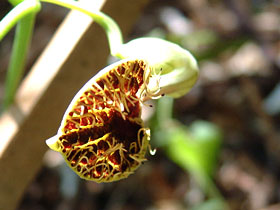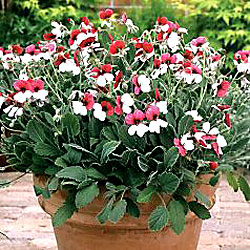
Dutchman's pipe vine has unusual, exotic blooms.
Most vines for low-desert landscapes need to be tough characters, full of
pomp and swagger as they cover stucco walls and ramadas through the endless
summer. And we want them to look good while they're at it, providing vivid color
for us to enjoy with our morning coffee. Trumpet vine, bougainvillea, cat's claw
-- these are the typical "go-to" choices for demanding
situations.
However, there are some unusual, little-known native vines
that are much less bold but still delightful. These shy creatures display
delicate, even wispy, foliage that doesn't appreciate broiling on stucco walls.
Their flowers are not so blatant and must be seen up close to be appreciated. I
planted three such characters in a sheltered location between a compost bin and
a bird bath. The bin shields them from direct sun, the soil is richer from years
of compost overflow, and the vines enjoy a bit of extra moisture when I clean
the bird bath. It's akin to a shady little woodland area complete with the
delights of discovery such a place offers.
Dutchman's Pipe
(Aristolochia spp.)
Last year I planted two Dutchman's pipe vines
that I found at a botanical garden sale. Aristolochia plants are larval food
sources for pipevine swallowtail butterflies. Pipevine plants contain toxins.
Caterpillars that feed on them absorb the poison, and in turn, become lethal
little morsels themselves, which is supposedly a deterrent to
predators.
The plants' common name refers to their oddball S-curved
flowers shaped like pipes (think Sherlock Holmes). Watson's Dutchman's Pipe
(A. watsonii) has long, narrow, arrowhead-shaped foliage. Mine hasn't
bloomed as yet, although references say it can flower anytime from spring to
fall. Flowers and foliage are an inconspicuous greenish brown. In nature, this
species scrambles along the ground, blending in with plant litter, so it's easy
to miss. So far, it is the least vigorous of my three vines. I recently added a
small trellis for it to climb out from under its unruly neighbors.
My
other Dutchman's pipe wasn't labeled with the species, but its heart-shaped
leaves and silver markings are far more distinctive than Watson's. It has just
started to bloom, which was a real treat to spot since the flowers are hidden
beneath the foliage. Deciduous, this vine disappeared completely late last
summer and I was afraid I'd lost it due to erratic watering while I was out of
town. But it popped through the soil this spring as temperatures
warmed.
Snapdragon vine (Maurandya antirrhiniflora)
A
friend spotted this plant at a local nursery and nabbed it for me since she was
so delighted with one she had purchased earlier. It has been flowering for two
months with tiny, violet snapdragon-shaped flowers. A perennial vine, its small,
arrow-shaped leaves are bright green, about a half-inch long, and it has
tendrils that twine and scramble up and over nearby plants, just as it would in
nature. There are also varieties with reddish pink flowers.


![[]](imap://a2002v2002@imap.aol.com:143/fetch%3EUID%3E/INBOX%3E19561207?part=1.2.1.2.1.2&filename=image0011.jpg)
![[]](imap://a2002v2002@imap.aol.com:143/fetch%3EUID%3E/INBOX%3E19561207?part=1.2.1.2.1.3&filename=image0022.jpg)
![[]](imap://a2002v2002@imap.aol.com:143/fetch%3EUID%3E/INBOX%3E19561207?part=1.2.1.2.1.4&filename=image0033.jpg)



